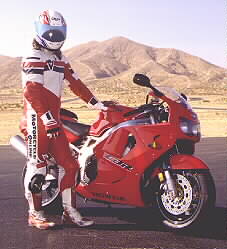Honda Lite: 1996 CBR900RR Riding Impression - Motorcycle.com
Honda brought out the old and the new to Willow Springs Raceway. The old: The 1995 CBR 900RR. The new: The 1996 CBR 900RR. Normally, motorcycles add weight with age, but not the CBR. It's back lighter and stronger than ever.
Honda made a big deal of "Optimized Mass Centralization" four years ago, when the CBR nine was first rolled out. Translated, the jargon means if the weight is in the center of the bike, it handles better. So the lighter all the extremities are, the easier it changes direction. And while we're lightening, why not lighten the big stuff too? That design credo introduced a 900cc sportbike with the weight of a 600 class machine. Four years on, OMC is still the word, and the new RR is the lightest, most powerful yet.
From the start, the CBR 900RR (better known as the Fireblade in some other parts of the world) earned a reputation as a super-sportster with a temper. Honda's aim this year was to keep the bark, lessen the bite. Power is up (depending on who you believe, the figure ranges from 123hp to 128 at the crank) due to a minimal 0.10 point compression ratio rise, and a significant 1.0mm overbore. The CBR now displaces 918cc (and if they'd called it that, they'd be two up on Ducati) totalling a 25cc boost. Previous cast-in cylinder liners lost their flanges and rough surface finishes.
A new casting technique allows non-flanged, smooth finished liners, and allowed Honda to overbore each cylinder without increasing the motor's overall width. Indeed, the width is down, narrowed 9.5mm with a new, more compact generator using a new unobtanium ferritic magnet compound. The bigger, only very slightly heavier pistons are matched by larger connecting rods with bigger crankshaft big end journals to match. Those much-ballyhooed holes are gone from the fairing sides -- though the front of the fairing still resembles swiss cheese, as does the rider's footpeg guard. Honda claims that the new, aerodynamic front fender with built-in air scoops does more to promote turning ability than the holes did. It's claimed also that the fender even circulates air under the fairing, helping to support the rider (the lower pressure air behind a fairing's bubble usually pulls the rider's neck and head down, leading to shoulder and back strain).
"In the interest of weight reduction, the drive chain is reduced in size from 530 to 525."
A whole list of parts has been lightened, including the tires (new Bridgestone BT56, designed to warm up to operating temperature sooner), the cylinder head cover (now magnesium) and even the frame. The new design of the frame and swing arm means that sections of the frame are now open-backed, instead of closed. The frame is triple-box section, instead of quad-box section as before, but is claimed more rigid in critical areas, although the frame's designers have actually gone for less rigidity in places, finding after extensive research something that seat-of-the-pants frame builders always knew -- a little torsional frame flex is good for handling.
Honda engineers were at pains to point out that lateral (side to side) strength is not compromised. A new, curved radiator keeps the same cooling area but decreases width.
There are also smaller, lighter, worldwide turn signals. The new tires, BT56F and BT56R Bridgestone Battlaxes front and rear, have a new tread pattern claimed to optimize cornering grip. The conventional front suspension has been reworked for lightness, and now boasts compression damping adjustability in addition to rebound and preload adjustment. Rear suspension has also been altered, with a smaller diameter piston claimed to give a greater range of adjustments, and a reworked linkage ratio giving more progressive damping over a longer amount of travel.
Even the transmission has been reworked to lessen the gaps between first through third gears, and provide a higher overall sixth gear. Likely the only changes the average CBR900RR owner will actually notice are the reworked handlebars, the 10mm higher seat and the much narrower, more svelte fuel tank. These improvements combine to give the CBR a much lighter, easier to handle feeling. Before, the tank would get in the way of knees and elbows when cranking in hard to a turn: Now the tank is not a barrier, and the bike feels smaller because of it. Power is, like before, seriously adequate. Bang the throttle up to the 11,000 rpm redline, and you'd better be pointed in the right direction.
The capabilities of this bike are frustrating at the track. It's one that repays seat time with even greater levels of performance. Or maybe I'm just rusty. Anyway, after many laps around Willow I found myself only just starting to trust the revamped Honda at the end of the day, and then even more amazed that it would go wherever I pointed it. Okay Honda, you've convinced me, lighter and more powerful means faster and better.
Specifications
Manufacturer: HondaModel: CBR900RRPrice: ,799Engine: dohc, 16-valve, inline-FourBore x stroke: 71.0 x 58.0mmDisplacement: 918ccCarburetion: (4) 38mm KeihinTransmission: 6-speedWheelbase: 55.1 in.Seat height: 31.9 in.Fuel capacity: 4.8 gal.Claimed dry weight: 403 lbs.
More by Andy Saunders, Editor






























Comments
Join the conversation